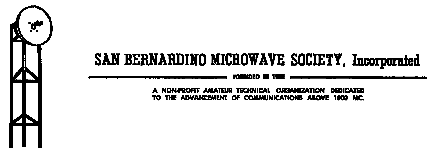

President: Doug Millar, K6JEY 2791 Cedar Ave Long Beach, CA 90806 562-424-3737 dougnhelen@moonlink.net
Vice President: Dick Bremer, WB6DNX 1664 Holly St. Brea, CA 92621 714-529-2800 rabremer@juno.com
Recording Sec:Mel Swanberg, WA6JBD 231 E Alessandro Blvd Riverside, CA 92508 909-369-6515 swanberg@pe.net
Corresponding Sec: Kurt Geitner, K6RRA 213 Main St. #5 Seal Beach, CA 90740 310-718-4910 k6rra@gte.net
Treasurer: Dick Kolbly, K6HIJ 26335 Community Barstow, CA 92311 760-253-2477 rkolbly@compuserve.com
Editor: Bill Burns, WA6QYR 247 Rebel Rd Ridgecrest, CA 93555 760-375-8566 bburns@ridgecrest.ca.us
Webmaster Chip Angle, N6CA
ARRL Interface Frank Kelly, WB6CWN 1111 Rancho Conejo Blvd. #501 Newbury Park, CA 91320
805-499-8047 fk@event1.com
FCC Interface Dave Laag, K6OW 11614 Indian St. Moreno Valley, CA 92557 909-924-1517
W6IFE License Trustee Ed Munn, W6OYJ 6255 Radcliffe Dr. San Diego, CA 92122 619-453-4563
edmunn@compuserve.com
The 5 July 2001 meeting of the SBMS will have Dick, K6HIJ talk about his experiences creating a WR-42 Waveguide Switch. Dick had two prototypes of the switch section at the May meeting to share with the membership. He hopes to have a full device to share at the July meeting. The SBMS meets at the American Legion Hall 1024 Main Street (south of the 91 freeway) in Corona, CA at 1900 hours local time on the first Thursday of each month. Check out the SBMS web site at http://www.ham-radio.com/sbms/.
Last meeting President Doug, K6JEY talked about various VLF 60 KHz comparators which have problems with solar cycle propagation and take a long time to measure oscillators. Another version is the Austron series LORAN receivers at 100 KHz that have quick updates. Kerry, N6IZW indicated the Qualcomm TCXO's are good from &endash;55C to +85C but with 3-ppm stability. Doug indicated that the Qualcomm TCXO's were relative unstable. Double oven crystal oscillators are much better but take a long time to become stable. Then there is GPS for better stability, followed by HP's 5370 comparator for nanosecond accuracy. Doug talked about his SynTac Software from Synergy Systems, LLC, which is used to control Motorola OEM GPS units. Doug had his UT plus unit which he demonstrated how it could be controlled the with software on a laptop computer. The software allowed the comparison of the 10 MHz output from his Rubidium standard to be checked against the 1 pps signal from the GPS. Bill, WA6QYR then talked about his adventures assembling the GPS based Frequency Reference from the 1998 QST article by Brooks Shera. Bill purchased the Motorola UT plus GPS because it had the RAAM internal program that compensated for the SA jitter in the satellites back in 98. In addition he purchased the mag mount antenna and amplifier so he could have an outside antenna and mount the rig inside. He purchased the manual on the GPS to since it had the Motorola binary code that you need to communicate with the GPS. Bill bought the A&A Engineering controller board and went to Brooks to get the programmed PIC microprocessor and the D/A chip. The rest of the parts were purchased from Mouser and Digikey. The commercial surplus VCXO was purchased off email from the east coast. Bill had assembled the hardware back in 98 and was testing it when something came up and the project sat until Doug started talking about it earlier this year. The controller has LED indicators that show that the GPS one-second "Heart beat" is working. In the set up mode the other LEDs tell if you are hi or low in frequency while setting the VCO. There is a switch to change polarity of whether your oscillator moves up or down with increasing voltage control. There is a switch to "open the loop" to the VCO. In set up mode you can open the loop and adjust the pots to the VCO to get it on frequency while the controller output is at zero. Then closing the loop the controller will move +/-3 volts to keep the vco on frequency. You need to calibrate your VCO so to set the correct resistive divider for the sensitivity of your vco. Set up mode keeps thing stable from the controller while you can look at the LEDs to adjust frequency or use the PIC 1 second out put with an analog meter to move the vco on freq. President Doug talked about the microwave rig test party by 50 MHz and Up group in Northern CA. Kerry, N6IZW talked about the rig test party to be held with the San Diego Microwave Group at the Fairview Park in Costa Mesa on 28 July. Kerry plans to have his equipment on site to test 10 GHz and 24 GHz wide or narrow bands all at one time. The event is scheduled to start at 11:00 am. 21 people present.
Activity reported at the 7 June SBMS meeting- Mel, WA6JBD had the modified 10 GHz MA/COM packaging complete; Dave, WA6CGR reported the first PSK31 contact on 10 GHz and has his rigs ready to operate between 160 meters and 24 GHz in the digital modes as well as all other modes; Chris, WB6HGW was happy to be back to a SBMS meeting; John, KJ6HZ has his 2304 MHz LO and preamps working and did some AO-40 testing and talked about working the Mars spacecraft on 437.1 MHz plus Doppler; Kurt, K6RRA worked on some splashier antenna feeds and had a small multi-band signal generator based upon a Qualcomm synthzier and a dip switch; Dick, WB6DNX had a demo of his Qualcomm rig hearing the Santiago beacon during the meeting and now has an FT-817 rig; Ed, W6OYJ had a sample of the comb generator which supports spikes from 10 MHz to 10 GHz, Ed had a new list of DX sites which will be on the web site soon, and indicated that the Frazier beacon is down while the tower is extended another 20 ft and that the beacon had been heard some 300 miles south of Palos Verde into Mexico; Kerry, N6IZW had more commercial surplus at the meeting and indicated adding a beam expander to his laser communication rig now making a spot 20 ft wide at 13 miles and has added SSTV and PSK31 to its modes of operation, Kerry has been collecting WR-90 waveguide to have a pile to get a mass produced 12 slot antenna made at machining cost; Chuck, WA6IGP was reported recovering and is doing well now; (a miss- quote correction the 5.7 GHz check-in to the San Diego net is on simplex via N6IZW, not tied into the repeater); Jim, K6ML is operating on 1296 MHz and making San Diego meetings; Dick, K6HIJ did work on the 24 GHz waveguide switch; Ivan, WA6WMF stopped by after some 8 years of being away and is off to North Carolina; Larry, K6HLH helped N6DN with his 2300 MHz rig; Sam, K6VLM did some 24 GHz work; Chuck, WA6EXV built up a 24 GHz dual mode feed and structure for a 4 ft offset dish for WA6CGR using standard copper water pipe and NIPCO bends which has 24 dB return loss following some Paul Wade info, and did some 2304 MHz beacon/ repeater work with Sam on the 1296-2304 translator, and married the 2 GHz and 24 GHz capability into his HP-8410 network analyzer now covering up to 40 GHz; Bill, WA6QYR put in some more work to the Qualcomm 10 GHz rig; Doug, K6JEY reported that Hiro and other JA's went to Dayton without much luck collecting parts, and he had been testing 432 MHz tubes;
Badges- the following badges are available from Dick, K6HIJ&emdash;AC6RM, Martin; AD6QL Carl; AL7EB Ed; K0BGL, Dale; K6ENS, Charles; KC6TFS, John; KE6BAA, Ed; KE6RCI, Eric; KF6HQC, Fred; KN6VR, Jeff; N2LIV, Bruce; N6DN, Paul, N6LL, Paul; NN6W, Gary; W6KL, Dave; W6ORG, Tom; W6ZKZ, Vince; W7CS, Chuck; W9DHK, Peter; WA5DJJ, Dave; WA6WAK, Charles; WA6YOJ, Gene; WD4MUO, John; WQ6S, Steve.
Scheduling
15 July Rig test day in Northern CA, WA6KBL
28 July Antenna/ rig test day in Fairview Park Costa Mesa, see directions in this issue.
2 August Program TBD
4 August UHF Contest
18-19 August ARRL 10 GHz and Up Cumulative contest 1st half
6 September Program TBD
8 September ARRL September VHF Contest
15-16 September ARRL 10 GHz and Up Cumulative contest 2nd half
Wants and Gots for Sale
Want sensor head for thermistor head for HP 432 Mel, WA6JBD 909-369-6515.
Want service manual for Systron Donner 1502 Signal Generator Sam K6VLM.
Want HP 1 MHz/ 10 MHz 101A manual or circuit, Dick WB6DNX 714-529-2800.
June Contest - The following came from a phone call with Chip, N6CA about the results of the trip to El Rosario, Baja California, Mexico DL29cw. Chip indicated that the pictures and some descriptive text is to appear on the website www.ham-radio.com where there will links to 6D2VHF (the call sign for the expedition) and to W6TOI (the rover operations at Mt Gleason, 6532 ft DM04vj). Chip had 38 900 MHz and up contacts with the shortest being 200 miles and out to 400 miles (Santa Barbara longest). The group in DL29 was made up of Jack, N6XQ; Chip, N6CA; Ramon, XE1KK; Roman, XE2EED; Keiji, JE6JYT; Mike, W6YLZ. Chip commented that Bob, W6SYA had a 60 over 9 signal from the LA area on 1296 MHz. The W6TOI multi-op rover group made up of Glenn, KE6HPZ; Bill, KB6WKT; Bill, N6RV and Ivan, KB6ATT use a 50 ft tower trailer with antennas on 6m, 2m 222, 432, 902, 1296, 2304 and 10 GHz.
They made 14 Q's, 9 grids on 902 MHz; 29 Q's, 11 Grids on 1296 MHz; 13 Q's, 10 Grids on 2304 MHz; and 9 Q's, 5 Grids on 10 GHz. The Diamond Bar group had gear on 5 and 10 GHz. Charles, N6EQ and Kurt, K6RRA made their first over 300 mile contacts on 10 GHz.
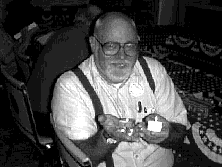
above: Dick, K6HIJ will be talking at the July SBMS meeting about the creation of a WR-42 Waveguide Switch which he is holding the first two prototypes. Dick has built the waveguide portion and is working on the solenoids to make it a useful device.
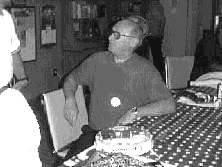
above: Ivan Alther, WB6WMF, a previous member of the SBMS in the 1970-80's and former Corona resident stopped by the May meeting to say HI before returning to North Carolina. Ivan is disappointed at the hams in other areas of the country that don't build hardware and get out and operate like the SBMS. Good to see you again Ivan!
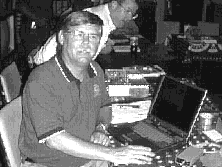
above: President Doug, K6JEY at his laptop computer during the May meeting showing off his GPS software and the deltas in frequency between his Rubidium frequency source and the GPS reference.
Re: the Microwave Picnic and ERP/MDS measurement workshop scheduled for July 28, 2001 at Fairview Park in Costa Mesa. Starting at 11:00 A.M. The following are the directions I sent to our San Diego Microwavers last year: Driving directions from San Diego: Go North on I-5 and take I-405 toward Long Beach. After passing John Wayne (Orange County) Airport take Harbor Blvd exit (South). Continue on Harbor Blvd to Adams Avenue and Turn Right. Go about one mile to Placentia Ave and Turn Left (South). After passing through the residential area you emerge into the park. Watch for the first parking lot on the Right Side. That's where we will be.
Those coming from the Long Beach direction on the I-405 will follow the same directions after turning right onto Harbor Blvd (South). 73s from Ed, W6OYJ
Words from Phil, W6HCC in Colorado- We have made some 24 GHz contacts up here in the high plains. By Calif. standards they are not very far, but these were over a non-line-of-sight path on the plains. We have good mountain sites, but I wanted to get a VUCC from home. I have good horizon looking north and south, but to the east, there is a ridge about 10 miles away, which obscures the horizon. I worked Don (N0UGY) in DM89 and DN80 over a distance of about 80 miles. (My QTH is in DN70lt.) The signals had very wild QSB. They went from S1 to S9 and would drop out so that you would miss whole words. Don was running 1 watt with a 12 in. dish and I was running 60 mw with a 24 in dish. My transmissions to Don were CW. (voice could have been done with great difficulty.) I also worked Bill (K0RZ) at his QTH in Louisville, which is about 50 miles to the south. This is not a difficult path and the signals were S9. Bill has a beacon on 24192.360 MHz, which I monitor daily to keep track of the path between our QTH's I also have a beacon on 24192.003 MHz, which he monitors. These contacts with others, which I have made from my QTH, complete my VUCC from home. 73, Phil, W6HCC
Included in this issue are the diagrams by SAM, K6VLM of the forth coming 1296 MHz to 2304 MHz translator to be positioned on Heaps Peak, DM14kf. Sam is building the translator and Chuck, WA6EXV is constructing the 2304 MHz amplifier and beacon. The plan is to have a beacon similar to the one, which served us for 15 or so years, but this will also switch to the translator mode when the 1296 MHz receiver hears a signal. Several stations can communicate through the device at the same time. Sam has completed the translator. Chuck is in the process of marrying the power amplifier to the translator.
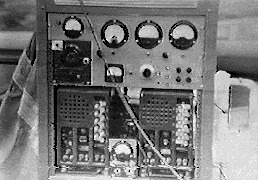
above: One of the ROCKLOC rigs from the past complete with BC-604, -453, -603, and Q5er. Photo from K6MBL files. The San Bernardino Microwave Society is a technical amateur radio club affiliated with the ARRL having a membership of over 90 amateurs from Hawaii and Alaska to the east coast. Dues are $15 per year which includes a badge and monthly newsletter. Your mail label indicates your call followed by when your dues are due. Dues can be sent to the treasurer as listed under the banner on the front page. If you have material you would like in the newsletter please send it to Bill WA6QYR at 247 Rebel Road Ridgecrest, CA 93555, bburns@ridgecrest.ca.us, or phone 760-375-8566. The newsletter is generated about the 15th of the month and put into the mail at least the week prior to the meeting. This is your newsletter. SBMS Newsletter material can be copied as long as SBMS is identified as source.
San Bernardino Microwave Society newsletter
247 Rebel Road
Ridgecrest, CA
93555
USA
73's
Bill